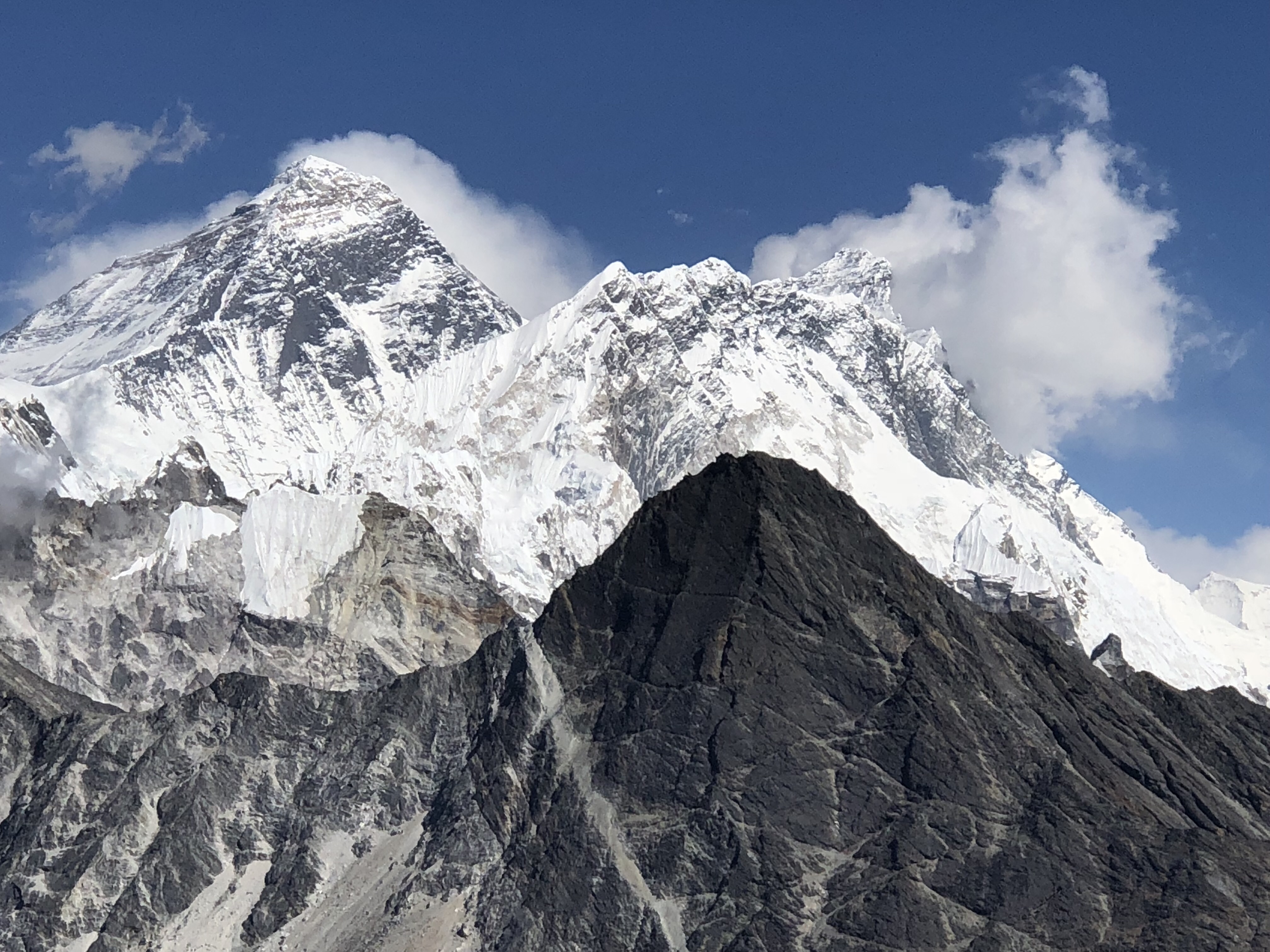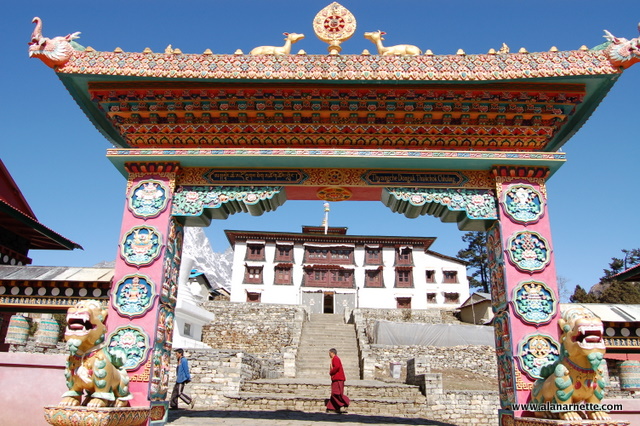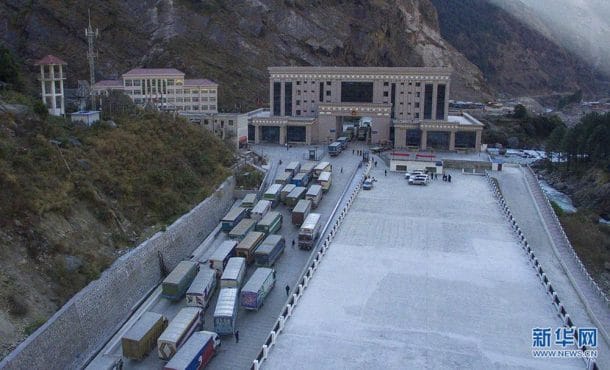Activity is picking up with climbers getting closer to Everest Base Camp plus many more have arrived in Kathmandu. The permits have increased as expected this past week but still lag behind last year. The fixed lines are now to Camp 2 in the Western Cwm. Teams will arrive at EBC this week. We saw the first 8000er summits of the 2022 Spring season this past week.
Big Picture
Well, as expected, the first summits this season occurred on the 8000er, Dhaulagiri. Mingma Gyalje expedition leader of Imagine Nepal put 11 Sherpas and ten clients on the summit. Consistent with early thoughts, the climbing permits are well behind last year’s pace, but I’m getting reports of a healthy trekking season. As of April 8, 2022, the Ministry of Tourism has issued 505 total climbing permits thus far with 204 for Everest. This is good news for tourism across Nepal from treks near Annapurna to Manaslu, and the Khumbu as the teahouses make more money from trekkers than climbers because there are more of them.
Many teams report arriving in Kathmandu and for those who flew to Lukla last week, they are well up the Khumbu. IMG, CTSS, Alpine Ascents and more have only one more night before making it to EBC. See the tracking table for the latest team locations.
The Icefall Doctors have reached Camp 2 at around 21,500-feet and used very few 4 ladders this year. I previously was told there were 12 in the Khumbu Icefall. We’ll verify once the activity picks up. The number of ladders has ranged from 30 to less than five depending on the number of crevasses and layout of the route from year to year.
The weather is reported to be normal for mid-April with clear mornings changing to clouds in the afternoon and a little snow now and then. Temperatures are well below freezing each night at EBC. By the way, online weather reports have it at -30C/-22F on the summit!
Last Week
IMG who is usually one of the first on the mountain to establish their base and high camps have claimed their C1 and C2 spots. They also acclimatize on the trekking peak, Lobuche East at 20075 ft / 6119 m. IMG gave this update:
Great news overnight from Mount Everest. IMG Guide Sherpa Fura and Gyalzen Dorje reached Camp 2! The two guides climbed well through the Icefall, reporting four ladders total right now heading to Camp 1. After securing the campsite at Camp 1 and having a quick snack and drink, they continued on to Camp 2 and reported that all is well and claimed that campsite as well. They are now back to Base Camp! This is a huge step towards climbing the mountain, and we are all thankful and proud to have Sherpa Fura and Gyalzen Dorje on the team.
Josh Garrison with the Madison Mountaineering team captured a nice moment that reflects how busy the Khumbu is with trekkers and climbers entering the Park. From this point on, no motorized vehicles are allowed, only foot traffic foot as in feet or hooves!

Dave Pritt over at Adventure Peaks told me, “Adventure Peaks Everest team climbed Lobuche East this morning as part of their acclimatization program on the way into base camp. Stu Peacock our expedition leader stated he felt the best summit weather ever! It’s at least a positive start with good early progress for Everest and the reduced numbers a big bonus!!! Initial reports from our Sherpa fixing team on Annapurna IV, best conditions they have seen and currently fixed to Camp 3. Climbing Team of 8 + our Leader arrive Kathmandu today. Full Team = 8 Climbers, Guide Di Gilbert and 8 Climbing Sherpas.”
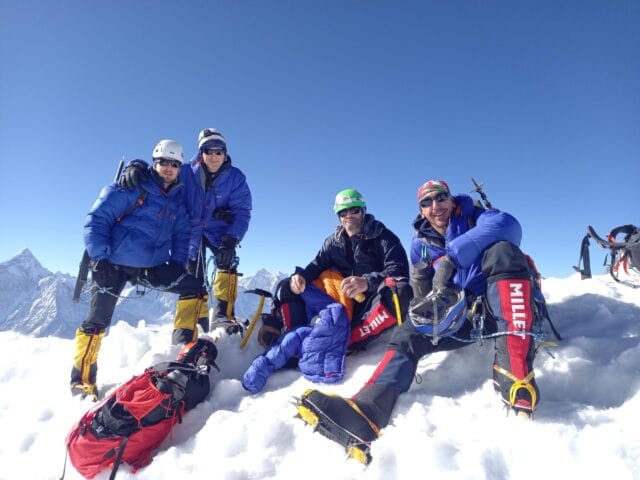
Female 8000er Record?
Pemba Sherpa of 8K Expeditions has an interesting client on his team. Kristin Harila, 35, from Vadso/Norway has an ambitious project she calls “Women Too” 14 peak project. This former cross-country skier turned mountaineer, runner, and skier has a Guinness female record when she summited Everest and Lhotse in 12 hours in 2021. She has also summited Dhaulagiri in 2019, Aconcagua in 2020, and Kilimanjaro in 2015 plus many more peaks in Norway and around the world. Now she wants to summit all 14 of the 8,000-meters peaks in six or seven months, setting a female record. Pemba tells me the first phase includes: Annapurna (she is there now), Dhaulagiri, Kanchenjunga, Everest, Lhotse and Makalu. The second phase has Nanga Parbat, G1, G2, Broad Peak, and K2.
8000ers
1. Mingma Gyalje Sherpa (Mingma G)2. Sashko Kedev3. Keval Hiren Kakka4. Tracee lee Metcalfe5. Christopher Bernard Warner6. Gina Marie Rzucidlo7. Haakon Aasvang8. Hong Dong Juan9. Anurag Reddy Nallavelli10. Naoki Ishikawa11. Jill Wheatley
12. Dawa Kamey sherpa13. Dawa Gyalje sherpa14. Chhiring Sherpa15. Vinayak Jay Malla16. Tamting sherpa17. Sonam Tashi sherpa18. Jit Bahadur Sherpa19. Kili pemba sherpa20. Thundu sherpa21. Pemba Tenzing sherpa22. Aangdu Sherpa
New Formula?
It’s fascinating how fast these 8000-meter climbs have become. A decade ago, climbs on these ‘other’ peaks, besides Everest, were somewhat rare and took weeks, if not two months. Some of the members who just summited this past weekend only arrived at Base Camp a week ago.
The large Sherpa-owned companies have honed a proven technique by having strong Sherpas break trail and putting the fixed-line in on well-known and proven routes. They establish high camps with tents, fuel and stoves, oxygen, and sometimes even carry the member’s sleeping bags, pads, and food. Once the route is set to the summit, the members clip into the fixed-line and follow the boot path to the top, climbing on more efficient oxygen delivery systems at higher flow rates than in previous generations.
Of course, not every climber follows this program. Still, others climbing “independent” definitely benefit from the fixed ropes and boot path.
Now, please don’t get me wrong. Even though this technique is distasteful to many old-timers, purists, armchair climbers, and journalists, it’s the style of today’s high-altitude climbing for the vast majority of climbers. But moreover, it’s opening the market to hundreds who otherwise would not have the opportunity. So while those who summited have critics, I’m happy for them.
I do believe there are two standards for climbing these days. The first category is what I’ll call ‘recreational’ climbers, and I would put myself into that group. The other group is “record-seeking” climbers. Those would include anyone purposefully attempting to set a record – speed, age, unclimbed, new route, etc.
While I believe style applies to both groups, the latter should be held to a higher standard. Those who use the recreational approach and claim a record deserve a high level of scrutiny, even though the feat might have been a fantastic display of strength, determination, and even skill. In other words, if you climb one 8000er, or fourteen, using a standard route, overwhelming the peak with super-strong support with everyone using supplemental oxygen, and then you claim you set a new record, that is a different style than most climbers who set a record ten or twenty years earlier.
Comparisons may not be equivalent, and the differences need to be pointed out to the admiring public, who may not be aware of such nuances. However, climbing is not the Olympics or even a sport with rules. It’s only a sport that depends on personal integrity to claim an accomplishment legitimately. And it takes a turn when someone claims a record, compares themselves to a previous record when entirely different styles were used, and there is no acknowledgment of the difference.
Next Week
This next week teams will arrive at Everest Base Camp and begin to call it home. However, several teams just arrived in Kathmandu this weekend and will fly to Lukla or Namche to start their trek. There will be a steady stream of climbers and trekkers from now through June. I expect to hear the fixed rope will get to Camp3 and perhaps even the South Col this next week. With such excellent progress on the ropes, look for earlier than usual summits this year – of course, assuming the weather doesn’t turn ugly. Usually, it cooperates through May but turns ugly in early June before calming down for suitable weather windows starting in mid-May. We’ll see this year.
Nepal Permit Update
The permits for Everest are coming slowly as expected but picked up last week. I’m looking for 300 foreigners to get Everest permits in total. 2021 was a record year with 408 permits issued to foreigners. The Nepal Ministry of Tourism posted these foreign permit tally as of April 8, 2022
- Everest: 204 on 23 teams (25 teams+ and 250 – 300 climbers expected)
- Lhotse: 52 on 6 teams
- Nuptse: 28 on 4 teams
- Manaslu: 9 on 1 team
- Annapurna: 26 on 4 teams
- Kangenjunga: 46 on 4 teams
- Dhaulagiri: 21 on 2 teams
- Pumori: 0 on 0 team
- Makalu: 15 on 1 team
- Ama Dablam: 39 on 4 teams
- Baruntse: 16 on 2 teams
- Gangapurna: 2 on 1 team
- Himlung: 16 on 2 teams
- Thapa (Dhampus): 6 on 2 teams
- Bhemdang: 8 on 1 team
- Mukot: 4 on 1 team
- Pokhar Kang: 9 on 1 team
- Urknmang: 2 on 1 team
The Khumbu
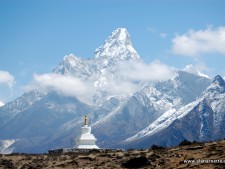
The Khumbu has changed dramatically over the past couple of decades. The teahouses have improved over the ones with poorly ventilated, dark, and cold rooms. Today, the newer ones have large windows, big tables seating entire teams, and excellent food and service. The sleeping rooms are still tiny, cold, and dark; but after a long day of trekking, most people don’t care.
The typical schedule is similar to this one:
- Trek to Phakding (or Monjo) at 8694′ (mostly flat to downhill)
- Trek to Namache at 11,300′ (significant uphill trek) visit the market, Everest museum, local schools, bakery, Everest View Hotel
- Rest day and tour in Namache
- Trek to Tengboche (or Deboche) at 12,683′ visit the Monastery, meet the Monks
- Trek to Periche at 13,907′ visit the Himalaya Rescue Association
- Trek to Lobuje at 16,174 see the Sherpa Memorial en route
- Trek to Gorak Shep at 16,924
- Climb Kala Patar 18,192′ with outstanding views of Everest Base Camp, Ama Dablam, and Mount Everest
- Trek to Everest Base Camp at 17,500′
In this narrative, I’ll describe the trek from Phakding to Tengboche
Phakding to Tengboche
Now in Packding, after the three-hour trek from Lukla, you settle into what will be the rhythm for the next week. After lunch of fried rice, you find your small room and layout your sleeping bag. Jet lag is hitting hard, and sleep comes easily. Unfortunately, your roommate also finds the room; soon, a cacophony of snorts, farts, burps, and snores fills the room. This expedition might be longer than you think, you say to yourself, smiling. Dinner comes and goes, as does a night of deep sleep.
Up at 6:00 AM, you have a relaxed breakfast and then leave for what some consider one of the more challenging days of a Khumbu trek: the infamous Namche Hill. Steep, dirty, hot; this will test your fitness and mental toughness. If this is your first time, you’re nervous based on the Hill’s reputation. However, if this is your 20th time, you smile, knowing your first view of Everest will be the reward.
But for you, this section to Namche is an absolute favorite. Your senses are quickly overloaded. The rhododendrons and cherry trees are in full bloom providing a bright red and white contrast to the green fields. Women tend to the fields, planting potatoes, barley, cabbage, and other food to meet their needs and service the teahouses. Local farm to table at its finest.

The dirt trail is dry, albeit rocky, and meanders high above the Dudh Kosi river. Its rushing water provides a natural audio accompaniment to the sights. The villages are spaced close together, each individual, filled with small children playing on the dirt trails with small balls, used water bottles, or simple sticks. The common theme is big smiles and loud laughs. Usually, a mother or grandmother washes clothes nearby or tends a field. Still, you know one eye is always on their most prized possessions. Many of the older kids are in school, so the trails are quieter than usual this mid-morning.
You make your way along the trail and soon stop for an early lunch just outside the Sagarmatha National Park entrance. The expedition leader handles the permit formalities, and soon the group continues the trek towards Namche. Again, the colors and sounds fill your senses.
The trail drops down to a steel cable bridge providing easy access across the raging rapids. You will cross many bridges today. Sharing the bridge with Zo’s, or more likely mules in 2022, loaded with gear; and porters, loaded with gear; you know your place and step aside when needed.
Finally, you cross one last high bridge to the base of Namche Hill. This bridge has one side covered with colorful prayer flags. They wave in the strong wind compressed by the tall rock walls of the river valley. You pause for a moment to take it all in. You count the prayer flags. They are always in the same order from left to right: blue, white, red, green, and yellow. Blue represents the sky, white the air, red symbolizes fire, green is water, and yellow is earth. All five colors together signify balance. There is a sense of peace listening to the flapping flags, seeing the different colors juxtaposed against the rushing glacier-fed river, and the sense that you are getting deeper into a special place on the planet.
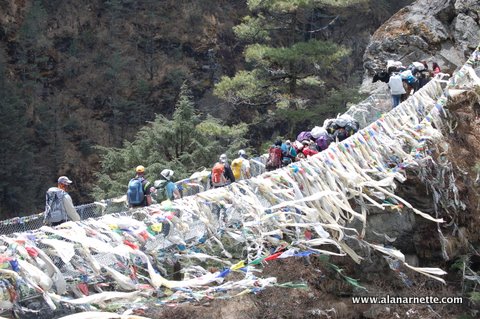
The Hill is about a 2000′ gain to the Khumbu capital and the largest village in the valley. It is the only way to get there by foot, so you share it with other visitors and locals. A small Zo train leads the way setting a pace exceeded only by a rock rolling uphill. You settled in place and accept a traffic jam in the middle of the Khumbu.
One by one, you passed the beasts as the trail widened. You steadily gain altitude as the heat of the day pushes through through the clouds. Each break was welcome. The trees provide shade and respite from the harsh sun at this elevation. The trail is worn from millions of steps over centuries. Trash cans supplied by the Sagarmatha Pollution Control Committee, SPCC, are strategically placed with signs asking visitors and locals alike to keep the trail clean of trash.
Suddenly, you see several people off trail to the right, slightly uphill. Then, through a break in the trees, there is Chomolungma, “Goddess Mother of Earth.” You forget the sweat pouring off your forehead, the pain in your left foot from stepping on a rock sideways, the need for a long drink of cold water to take the edge off. No, you are fully overtaken by the view—her vast white plume full of snow, clouds, and ice crystals blasts off the summit. The jet stream is almost on top of the towering peak. The plume is enormous and can be seen from space.
Your moment is interrupted by the clanging bells dangling under the long Zo necks. A mule train passes by. There seems to be a battle between mules and Zos for who gets a job carrying beer to the local villages. I think neither wants the job. The trees begin to thin as you gain elevation, and a few non-descript buildings start to appear. Another checkpoint holds customs officials wanting more money. The trail leaves a treeline near 11,000-feet. Another bend of the trail and yet another, finally another, bring your destination into sight, Namche Bazaar. It had taken six hours and an elevation gain of 2,724-feet. Welcome to Namche Bazaar, your home, for the next three days.
Namche Bazaar
The one-time sleepy village hand-built with stones carved from a local quarry is now the center of the Sherpa culture in the Khumbu. There are more spiritual, peaceful, and quiet villages ahead like Pangboche, but Namche is the center of commercialization.
In the ‘old-days’ circa pre-2000, Namche offered comfortable teahouses, a few nice bakeries, and stunning views. Today is all that and a top-notch gear store, multiple bars that turn into discos at night, even high-end coffee shops. And, of course, every establishment offers high-speed WiFi with electrical plugs at every seat to recharge mobile phones. The village even built a modern-day sculpture garden of sorts with a paved stream down the middle. But, it still leads to a large pool where women hand-wash clothes and lay them on the rocks to dry.
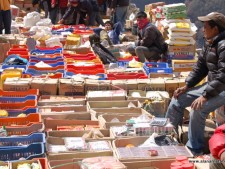 Yes, a dichotomy of yesterday and today as the pressure of tourism slowly chips away at the charm of the old world. Old-timers will remember the Namche market back in late 1990 when villagers came from as far away as Tibet to buy goods they couldn’t grow and harvest themselves. There were huge slabs of yak, Zo, and cow meat, colorful baskets of every grain imaginable, Chinese-made canvas shoes, spices, and more. For the visitors, it was a living Disneyland; for the locals, it was a way of life.
Yes, a dichotomy of yesterday and today as the pressure of tourism slowly chips away at the charm of the old world. Old-timers will remember the Namche market back in late 1990 when villagers came from as far away as Tibet to buy goods they couldn’t grow and harvest themselves. There were huge slabs of yak, Zo, and cow meat, colorful baskets of every grain imaginable, Chinese-made canvas shoes, spices, and more. For the visitors, it was a living Disneyland; for the locals, it was a way of life.
You spend two nights in Namche to let your body catch up with the altitude. You are now at 11,286-feet or 3,440-meters, not all that high compared to where you are going. You pass the time walking the stone-paved or dirt streets dodging the yak trains – now there are yaks, the mules relegated back down the valley. It’s time for the professionals to take over hauling heavy loads higher.
In the early morning and late afternoon, the streets fill up with kids running to or from school. They pass you by at antelope speeds while you are still in sloth mode, struggling to catch your breath. It can’t be the altitude; you trained for this. Maybe it was that third beer at the Irish Cafe you had over lunch?
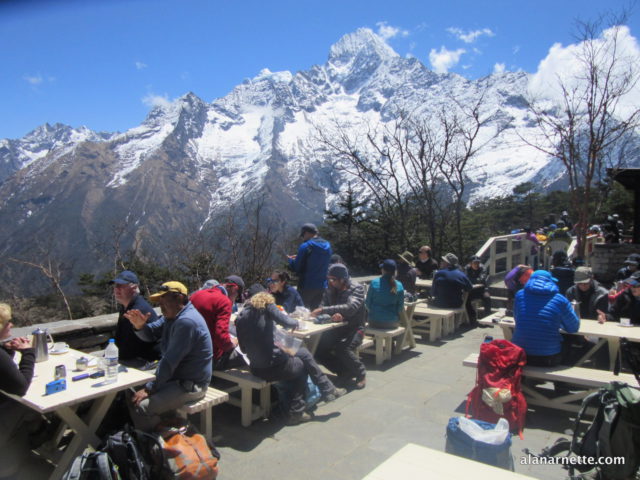 The second day is what the guide calls an ‘active rest-day.’ You are confused by the obvious contradiction of terms. Are we resting or not? The Everest View Hotel is on the docket today. Built for the Japanese in 1971, it’s perched on a ridge at 3880-meters/12,730-feet. In the beginning, it was popular to helicopter to the Hotel and spend a few nights in the rarified air. Still, there was one problem: the guest got very sick due to the altitude, and some even died. Today, there is supplemental oxygen in each of the 12 rooms and electric blankets and WiFi!
The second day is what the guide calls an ‘active rest-day.’ You are confused by the obvious contradiction of terms. Are we resting or not? The Everest View Hotel is on the docket today. Built for the Japanese in 1971, it’s perched on a ridge at 3880-meters/12,730-feet. In the beginning, it was popular to helicopter to the Hotel and spend a few nights in the rarified air. Still, there was one problem: the guest got very sick due to the altitude, and some even died. Today, there is supplemental oxygen in each of the 12 rooms and electric blankets and WiFi!
Your team meanders along the dirt trail tripping over the smallest rock because Ama Dablam and more capture their view. Soon the Hotel comes into view, about an hour from your lodge in Namche. You climb the steps to the hotel lobby and are ushered to the verandah in the back, where your objective lies in wait.
You are fortunate, not a cloud in the sky. So for the first time, you have a crystal clear view of the world’s highest peak, along with the 4th highest, Lhotse. Nuptse, a bit under 8000-meter complete the horseshoe-shaped Western Cwm. You will see all of this much closer in a few weeks. And the ever-present Ama Dablam looms high over the Dudh Kosi. But for now, you enjoy sipping a cappuccino from a bone-china coffee cup on the patio outside the hotel, along with one hundred other gawkers! OK, just one more picture.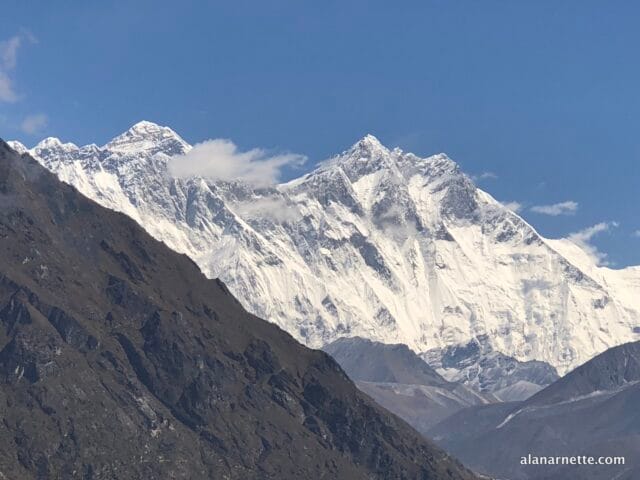
The Trek Between Namche and Tengboche
It’s time to move on and higher. This section is perhaps the most beautiful section of a trek to Everest Base Camp. You have it all, deep pine and rhododendron forests, rushing rivers, steep hillsides, sharing the trail with yaks, mules, and Zo, and finally gaining serious altitude. Namache is 11,286-feet, and the Tengboche Monastery, 12,687-feet.
Leaving Namache, you take the well-worn wide dirt path around a lazy corner only to have the world unveiled right before your eyes. Ama Dablam is always there but also early on in this section, Everest, Nuptse, and Lhotse stand out if the clouds allow. It’s virtually impossible not to stop every few steps or take just one more picture, especially of Ama.
Up and Down
As you move further, the trail drops steeply into the dense forest. Your mind is preoccupied with having to regain all this lost elevation in a couple of hours because the bottom is a bridge crossing the Dudh Khosi at Pungi Thanga. After a well-deserved break and hearty lunch of fried rice, you begin the steep uphill climb towards the Monastery.
Crossing the bridge you pause to admire the sheer force of the rushing water. Being Spring, this is full glacial melt and the flow is impressive. You watch a leaf or a stick as it’s tossed around until you tempt yourself with a small case of vertigo.
Back to reality, you finish crossing the bridge and look around. You are in a deep forest filled with silver fir, birch, rhododendron, and juniper trees. The thickness of the forest is impressive. It’s easy to lose sight of a teammate not too far ahead or behind. But everyone stays on the dirt trail as it begins the journey every higher.
Another “ah-ha” moment is when you realize Namche Hill was nothing compared to this, and then you understand. The Himalayas and trek to Everest Base Camp or to the summit of Everest reveal themselves in simple stages. Not too fast, not too harsh, but on an easy progression that pulls you deeper and deeper into the journey.
The forest thins a bit as the trail hugs the ridges. At one point, water is running freely from a stream onto the hillside. A few Monks in their crimson robes are huddled around the pool. It’s unclear if they are gathering water, washing, or just doing what Monks do – connecting with Mother Earth. But you take it as a good sign that the Monastery must be close by. Another trick.
Tengboche Monastery
The trail gains more and more elevation and you begin to count each step. Today you brought two liters of water and are glad as when you break through the trees the sun is not shy about lighting the path and warming the earth.
And just when you think this might not end, a rock gate appears – seemly out of now where. A gateway to where? You walk through the wide arch and enter the grounds of the Tengboche Monastery. Directly ahead is a wide grassy field. A small group of yaks is grazing, gentle in their mass and with their steps. Their bells tell everyone around that this is their home and you are a visitor.
To the left rises the Monastery. A simple but impressively colorful structure with stone steps leading up to the inner ground and more steps to the Monastery itself. You take a few more steps to see for yourself but are a bit surprised to see three elder Monks standing on a porch. They are quietly talking when all of a sudden one erupts into a deep, bellowing laugh that echos within the walls of the inner ground. The other Monks smile. And so do you.
You are now at 3,867-meters/12,687-feet. This monastery was built in 1916 as a companion to its mother monastery, the Rongbuk Monastery, in Tibet. It also serves as a gateway to Everest. In 1934, the Tengboche Monastery was destroyed by an earthquake and by fire in 1989. Both times it was rebuilt with the generosity of volunteers.
Tomorrow, you might return for prayers as a guest inside the Monastery. The Monks are generous with their rituals and open to all who show interest, but no pictures are allowed during their prayers. But for now, your guide sends you to the bakery at the end of the grassy area for coffee and pastries. You don’t argue.
Tonight will be spent a short walk downhill in another comfortable teahouse with a morning view, you simply cannot imagine.
Climb On!
Alan
Memories are Everything
Follow Along!
I’m updating my annual team location table and track climber’s blogs (see sidebar). If you have a team not listed, please let me know, and I will add them if I can track them. Likewise, please contact me if you prefer not to be mentioned. Finally, if you would like to see anything special this year, post a comment or drop me an email.
Here’s the video podcast version of this weekend’s update:
The Podcast on alanarnette.com
You can listen to #everest2022 podcasts on Spotify, Apple Podcast, Google Podcasts, Pocket Casts, RadioPublic, Anchor, and more. Just search for “alan arnette” on your favorite podcast platform.
Why this coverage?
I like to use these weekend updates to remind my readers that I’m just one guy who loves climbing. With 35 serious climbing expeditions including four Everest trips under my belt and a summit in 2011, I use my site to share those experiences, demystify Everest each year and bring awareness to Alzheimer’s Disease. My mom, Ida Arnette, died from this disease in 2009 as have four of my aunts. It was a heartbreaking experience that I never want anyone to go through thus I ask for donations to non-profits where 100% goes to them and nothing ever to me.![]()

Previous Everest 2022 Season Coverage Posts
- Everest 2022: Welcome to Everest 2022 Coverage
- Everest 2022: Climbers Leave for Nepal
- Everest 2022: Icefall Doctors leave for EBC and Ukraine Guide Bans Russians
- Everest 2022: A look at This Spring’s 8000ers
- Everest 2022: Leaving Nothing Unsaid
- Everest 2022: Weekend Update March 27 – And We’re Off!
- Everest 2022: Climbers to Watch – Updated
- Everest 2022: Weekend Update April 3 – Trekking
- Everest 2022: The Moments I First Considered Climbing Everest, and Your’s?
- Everest 2022: Interview with Garrett Madison from Namche Bazaar

